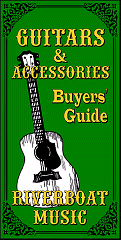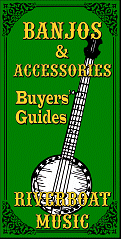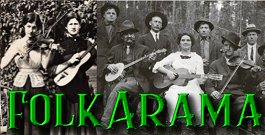
The Three-Chord Pattern that Defines Countless Songs
| Please Read: How to Help Our Site at No Cost to You - Some of our articles contain recommendations for products we like and vendors we personally trust. Some of those vendors may pay us a very small commission if you click on a link and buy their products. This costs you nothing at all and helps offset the costs of what we do. So if we point you to something you decide to buy later, please make certain you come back through our site and click on the link directly. Thanks. |
| This Site is a Cookie-Free Zone - Except for discussion forums that you have to expressly register for, none of our pages use cookies of any kind. Some of the vendors we link to do, but that won't affect you unless you click on a link to their pages. Your continued use of this page indicates that you agree to our policy. For details, click here. |



|


What is a "Three-Chorder"?
This is part of the "VERY Basic Guitar subset of our "How To Folk" articles. In an effort to "jump start" your enjoyment of Folk music and your ability to join in, no matter what instrument you play, we are providing some very basic notes about guitar chords.

 Note: - This part of the Folkarama page, which is dedicated to helping beginners "get into" Folk music and join Folk communities as easily as possible, with simple articles and links to resources that provide hands-on instruction in traditional acoustic instruments.
Note: - This part of the Folkarama page, which is dedicated to helping beginners "get into" Folk music and join Folk communities as easily as possible, with simple articles and links to resources that provide hands-on instruction in traditional acoustic instruments.
Folkarama, in turn, contains many references to more extensive articles and resources in Paul Race's CreekDontRise.com site, as well as other related pages.
 Why Are 3-Chord Songs so Prominent?
Why Are 3-Chord Songs so Prominent?
Technically, any song that uses three chords is a "three-chord song." But when a musician says a song is a "three-chorder," he or she is saying something about the structure of the song that helps other musicians to join in without sheet music, chord charts, or lead sheets.
In a true "three-chorder," the chords are mathematically related. Using G, D, and A7 as examples:
- If you play a G scale on the piano, the fifth note is a D.
- If you play a D scale on the piano, the fifth note is an A.

So D is to G as A is to D. When you learn more chords, like E and C, you'll see that those relationships continue throughout the scale. G is to C as D is to G as A is to D as E is to A, and so on.
For now, we'll ignore the other chords and just concentrate on the E, A, D, G, and C chords.
A "three-chorder" is any song that uses any three ajacent chords on that list, with the "middle" chord being the tonic (the key of the song). So:
- A song in the key of G that uses G, C, and D (or D7) is a "three-chorder."
- A song in the key of D that uses D, G, and A (or A7) is a "three-chorder."
- A song in the key of A that uses A, D, and E (or E7) is a "three-chorder."
The following diagram illustrates these relationships among several popular root-position open guitar chords.

To see an expanded version of this chart, showing the major chords and keys between F and B7, click here.
At first, many students find these chords arbitrary, like memorizing the "I before E except after C" rule. But the truth, the relationships among chords like those in our example above are determined by physics. You can pretend this stuff doesn't matter, of course, but it does explain why a lot of music depends on three-chord structures (even if the pieces use other chords).
It also explains how experienced musicians can follow along on so many songs just by knowing what key a song is in.
Or how quickly many musicians can transpose (change the key a song is in).
Let's say you generally play a three-chorder in D. But the songleader would rather play in G. The three chords you're used to using a D, A7, and G, but - once you've really got ahold of this concept - you should be able to jump to using G, D7, and C without hesitation. Or A, E7, and D, for that matter. The relationships among each of those three-chord "clusters" is exactly the same.
When is a Three-Chord Song Not a "Three-Chorder"? Some songs that use three chords are not "3-chorders" in the sense most musicians use. A song in the key of D that uses, say, D, C7, and A7 would not be. The chords are not adjacent.
In fact a song like "If I were a Carpenter" that uses the chords D, C, and G, is not - technically a three-chorder, because the song is in the key of D and the middle chord of that grouping is G.
More Information about Chord Relationships - If you want to learn more about, say the relationships among chords we haven't discussed here, and even different kinds of chords we haven't got to yet, you can probably find what you need in Creekdontrise.com's articles on the Circle of Fifths.
Why Do Three-Chorders "Work"?
You probably don't have to know this next part right now. If you've learned all you need to know for now, save this page and come back to it later.
If you eventually want to compose or arrange songs, you're going to learn it one way or another, though.
If the song's melody never strays from the major scale of the tonic key, all the notes you need to harmonize it are embedded somewhere in those three chords.
Back to our D chord, the D major scale contains these notes: D, E, F#, G, A, B, C#.
The chords that traditional players use depend on which of those notes are the important notes of each measure (you don't have to harmonize every note, just the ones that are held for a bit or otherwise stressed).
- The D chord includes D, F#, and A, so if you're singing any of those notes, D is fine.
- The A chord includes A, C#, and E, so if you're singing any of those notes, A (or A7) is fine.
- The G chord includes G, B, and D, so if you're singing any of those notes, the G chord is fine.
The following chart illustrates this.

You'll notice that some notes are included in two different chords, but some only appear in one chord. If a song in D includes a held G or B note, a G chord will cover it. But if the song holds a D note, you can play a D or a G chord. If the song holds an A, you can play a D or an A7. And so on.
Of course there are other notes and other chords. A song that never strays from the D scale may still use chords that are outside of the three-chord format. And songs that use notes that stray from the D scale (say by using a C natural or a G#) often depend on chords and chord progressions that are outside the "three-chord" format. That's fine.
But once you really understand "three-chorders," you'll never need chord charts for 80% or more of the traditional or tradition-inspired music you'll encounter in Folk, Bluegrass, our Country circles (and even a lot of Pop).
Conclusion
You'll eventually notice that even songs that have many other chords make use of the relationships we've described. For example, in the key of D, the strongest transition between chords is from A7 to D. If you play a song in D, but stop on an A7 (or A major), people will practically beg you to "resolve" to a D. And even composers who use a multitude of chords count on that principle when they're composing the last line of a tune. If the song ends in D, you can almost bet on the next to the last chord being an A7.In case you wondered, the second strongest transition in the key of D is from D to G. And you can make it even stronger by changing the D to a D7 before you change chords.
In other words, internalizing the principles of 3-chorders will help you play along with and even write songs that are far more complex than the ones we discuss or list in our "3-Chord Songs" articles. With each basic principle you internalize you're laying the foundation for greater things.
Other Resources
Related resources include:- Meet Your Guitar - A brief introduction to the parts of the guitar and how to hold it.
- Three Magic Chords - A series of articles that get you started on basic chords you can use to play thousands of songs. Articles include:
- 3-Chord Songs in D - A list of songs you can easily play in D, using G and A7.
- More Useful Chords - "Next steps" to expand your range and enable you to play even more songs, including:
- C and C9 Chords - Once you've learned the "Three Magic Chords," the C chord will help you play thousands of 3-chord songs in G, but some folks find it cumbersome at first, so we've given you a "workaround" to use while you're getting used to it.
- It's All Relative - Am and Em - The fingerings and most common uses of guitar's easiest minor chords, Am and Em. We also sneak in Am7, Em7, and Bm7 to expand your chord vocabulary.
Other resources will be listed as I get to them.
- 3-Chord Songs in G - A list of songs you can easily play in G using G, C9 (or C) and D7.
- The Circle of Fifths - a deeper discussion of the relationships among chords, something that helps musicians quickly learn or follow new songs, or even transpose them to other keys. (This is on our sister site, CreekDontRise.com)
Sister Sites
 Other sites we started to keep this site from getting too big to be useful include:
Other sites we started to keep this site from getting too big to be useful include:
- CreekDontRise.com is a repository of articles about Folk music and the instruments on which it has been traditionally played.
The "Acoustic" page includes a long list of articles including maintenance and playing tips on all sorts of traditional acoustic instruments.
 RiverboatMusic.com is a buyers' guide for acoustic and traditional instrument from a musician's point of view, focusing on the uses, reliability, and practicality of various instruments, and not just the marketing hype about the shape of the fret markers or whatever.
RiverboatMusic.com is a buyers' guide for acoustic and traditional instrument from a musician's point of view, focusing on the uses, reliability, and practicality of various instruments, and not just the marketing hype about the shape of the fret markers or whatever.
For instruments like dulcimers that have mostly small manufacturers or cheap imports, we try to tell you what to look for, irrespective of brand.
 Momma Don't 'Low includes a free e-mail newsletter that discusses all of those topics above and more. We plan to include other features as time permits.
Momma Don't 'Low includes a free e-mail newsletter that discusses all of those topics above and more. We plan to include other features as time permits.
Note - If you wish to sign up for our newsletter and ask a question at the same time, please click on the Momma Don't 'Low newsletter button to learn more and to get a link to our signup form.
 PaulRaceMusic.com is the "landing page" for Paul's own musical endeavors, plus many memoirs and blogs about music and the music business.
PaulRaceMusic.com is the "landing page" for Paul's own musical endeavors, plus many memoirs and blogs about music and the music business.
 ClassicTrainSongs.com describes railroad songs that every train lover should know. Or at least know about.
ClassicTrainSongs.com describes railroad songs that every train lover should know. Or at least know about.
- SchoolOfTheRock.com has articles about Christian music, Christian music careers and performance, Christian living in general, and vintage saxophones, another of Paul's interests. This site has separate newsletters, etc., by the way - there isn't a lot of overlap with the Momma Don't 'Low(tm) newsletters.
For information about other music collections and projects, check the links at the bottom of this page.
 Whatever else you get out of our pages, I hope you come away with some great ideas for "sharing the joy."
Whatever else you get out of our pages, I hope you come away with some great ideas for "sharing the joy."
And please stay in touch!
All material, illustrations, and content of this web site is copyrighted (c) 2001, 2002, 2003, 2004, 2005, 2006,
2007, 2008, 2009, 2010, 2011, 2012, 2013, 2014, 2015, 2016, 2017, 2018, 2019, 2020, 2021, 2022, 2023 by Paul D. Race. All rights reserved.
Creek Dont' RiseTM is a participant in the Amazon Services LLC Associates Program, an affiliate advertising
program designed to provide a means for sites to earn advertising fees by advertising and linking to Amazon.com.
For questions, comments, suggestions, trouble reports, etc. about this page or this site, please contact us.
| Visit related pages and affiliated sites: | |||||
| - Music - | |||||

|
 |
 |

|

|

|

|

|

|

|

|

|

|

|

|

|

|

|
| - Trains and Hobbies - | |||||
 |

|

|  |
 |

|
| - Christmas Memories and Collectibles - | |||||
 |

|
 |

|
 |

|
| - Family Activities and Crafts - | |||||
 |

|

|

|

|

|

